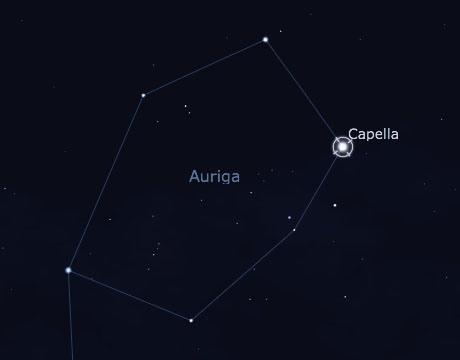Capella:
The sixth brightest star in the sky and the alpha star in the constellation Auriga is Capella. Interestingly, Capella is actually a quadruple star system not an individual star. The brightest elements is a spectroscopic binary, detected only through the shifting of light in its spectrum as its two stars move back and forth around each other in a period of 104 days. The two stars share the Capella name, with the first called Capella “Aa” and the other Capella “Ab”. The brighter, Capella “Aa”, is a class G8 giant with a magnitude of 0.76, while “Ab” is a class G0 giant with a magnitude of 0.01. Both of these stars are yellow giants, similar in color to our Sun but much brighter. They produce 80 and 50 times the energy of our Sun respectively.
The other two stars, in the quad, are a pair of faint red dwarfs with a magnitude of 10.2 and 13.5. These two are perhaps as much as a light year away from the central giants and they take millions of years to complete a single orbit. So Capella, as we see it, is in fact a cluster of four star.

.
Capella Overview:
- Constellation Auriga
- Alpha (α) 5h17m, +46°
- Type Multiple star
- Magnitude 0.1
- Luminosity 93 Suns
- Spectral Type G8III
- Distance 42 light years
Auriga (aw-RYE-guh) Constellation … The Charioteer
The brightest northern constellation of Auriga is host to the prominent yellow star Capella. The Greeks saw the pattern as a homage to the legendary Athenian king Erichthonius. Auriga represents a charioteer. With his right hand grasping the reins of a chariot, while on his left arm he carries a goat and its two kids. Capella’s name means “the she goat’, and the star represents Amaltheia, the goat that suckled the infant king of the goats, Zeus, when his mother had to hide him from his father Cronus.
